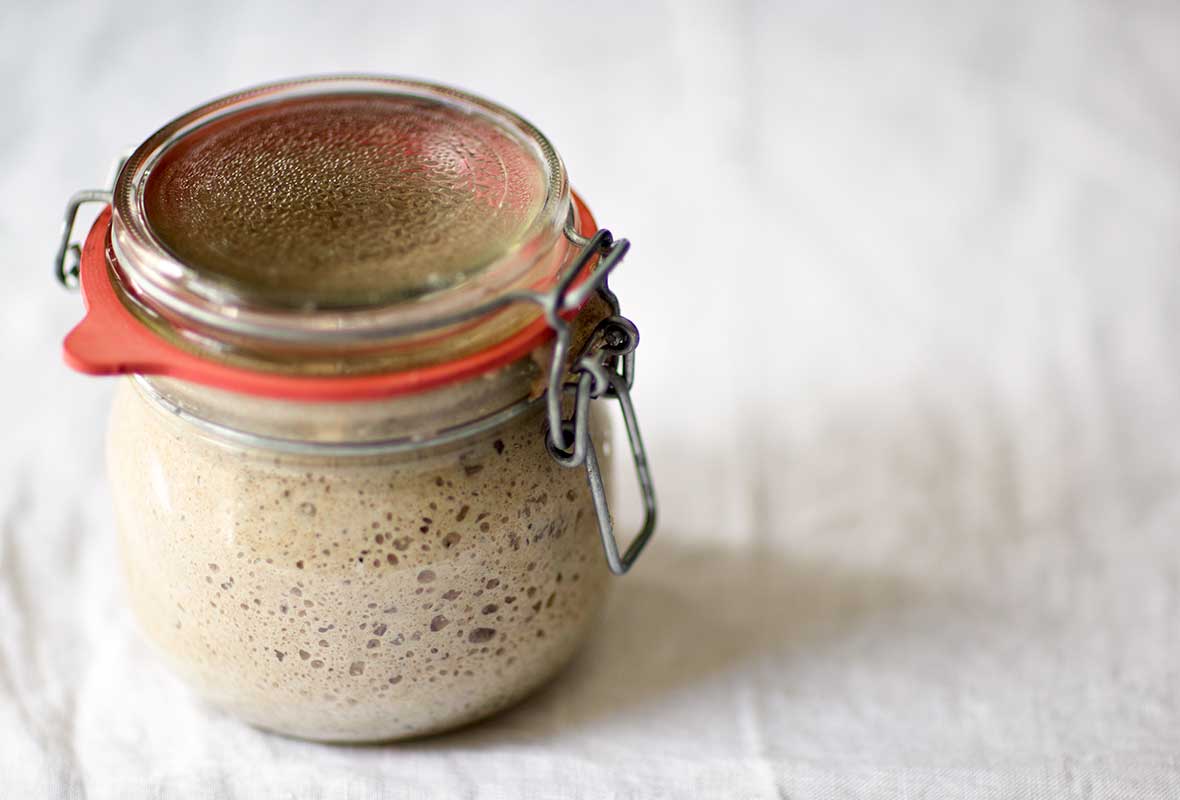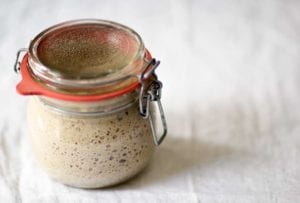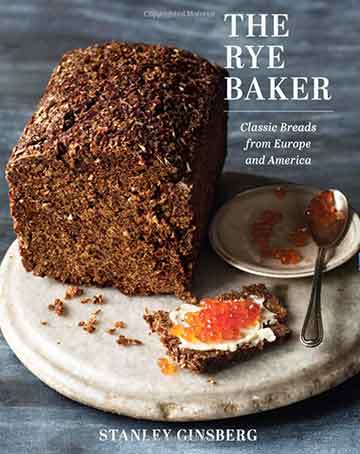
It’s not hard to make a rye sourdough starter from scratch. Some sourdough starters rely on wild yeasts that live in the air, others on acid-producing bacteria present in buttermilk, yogurt, pineapple juice, and the like, and still others start with commercial yeast or store-bought starters. Fact is, none of these additives is necessary. All it really takes to build a delicious and robust rye sour culture, or starter, is some whole-grain rye flour, water, a warm place, and patience. [Editor’s Note: And when your traditional rye sourdough starter is complete, the very first thing you’re going to want to do is use it to make this Galician rye bread.]–Stanley Ginsberg
☞ LEARN MORE, READ: HOW TO DRY SOURDOUGH STARTER

Rye Sourdough Starter
Ingredients
Day 1: Make the Rye Sourdough Starter
- 2.5 ounces whole grain rye flour, preferably organic
- 2.5 ounces warm water (105°F or 41°C)
Days 2 to 7: Refresh the Rye Sourdough Starter
- 2.5 ounces whole grain rye flour, preferably organic
- 2.5 ounces warm water (105°F or 41°C)
- 2.5 ounces Sour Starter from the preceding day
Days 8 and Beyond: Maintain the Rye Sourdough Starter
- 2.5 ounces medium or whole-grain rye flour, preferably organic
- 2.5 ounces warm water (105°F or 41°C)
- .25 ounces rye sourdough starter
Instructions
Day 1: Make the rye sourdough starter
- Start with equal amounts of organic rye flour and water by weight. Dump them in a nonreactive (glass, porcelain, stainless-steel, plastic) container, mix by hand into a stiff paste, cover, and let stand at room temperature (68 to 72°F or 20 to 22°C) for 24 hours.
☞ TESTER TIP: Occasionally the yeast normally present in whole grains fail to establish itself in a new culture; if, after 3 or 4 days, the culture darkens, develops a mold, or smells bad, dump the whole batch and start over. After a week, the culture, or sourdough starter, will be ready to use or to be stored refrigerated in an airtight container for a couple days. [Editor's Note: If storing the sourdough starter for more than a couple days, you'll need to maintain it, which we explain how to do just below.]
Days 2 to 7: Refresh the rye sourdough starter
- The next day, discard all but 2 1/2 ounces (70 grams) of the culture and mix the remainder with the refresh ingredients, cover, and let stand. Repeat each day, discarding all but 2 1/2 ounces (70 grams) of the preceding day’s culture.
☞ TESTER TIP: The most important point to remember at the early stages is to feed the sourdough starter daily. Even when it shows no apparent fermentation, the yeast is busy multiplying and consuming nutrients at a very high rate. By the second or third day, it will swell, show bubbles, and give off a clean sour smell. Over the next few days the activity will become more and more vigorous and the smell more intense.
Days 8 and Beyond: Maintain the rye sourdough starter
- In a perfect world—or in a working bakery—sourdough starters are refreshed daily. That said, daily feedings demand both a degree of dedication and abundant flour supplies that are impractical for all but the most committed home bakers. You can get by refreshing your starter every 36 hours or so.
- Mix the rye flour, water, and rye sourdough starter by hand until incorporated. Cover and ferment at room temperature (68 to 72°F or 20 to 22°C) overnight or for 10 to 12 hours. The sponge will be very bubbly, have a clean sour smell, and will have tripled in volume. Store refrigerated in an airtight container and it will last indefinitely.

Nutrition
Nutrition information is automatically calculated, so should only be used as an approximation.
Recipe Testers’ Reviews
The rye starter was easy to make and quick. It took about 5 minutes each of the 7 days. Mine smelled great and seemed consistent after the week of feedings. I switched to the refresh amounts after that and it stayed nice and healthy.
During the buildup, you end up tossing about 2/3 of it away. I definitely recommend a scale versus just using volume measurements.










Is 0.25 a typo under day 8? Shouldn’t it still be 2.5oz? Thanks!
Hi, Rachael, and thanks for checking in. Actually, it’s not a typo. At that point, you’re really just keeping the starter alive, not growing it.
Got it! Is there any harm in maintaining the starter at that size? I refreshed it last night using 2.5oz, and refrigerated it this morning. Bubbly and about the same size as past starters I’ve maintained. Thank you!
That should be absolutely perfectly fine, Rachael.
Thank you for your site. I tried making a sponge today but it has not tripled, nor double in volume. It smells ok and bubbles when I stir it. Possibly it is too cool? Should I increase the temperature and wait for another 10 hrs or start the sponge over? I have extra starter.
Denise, you’re entirely welcome. Let’s start with the easiest troubleshooting. Find a warmer spot and check in on the sponge tomorrow. I find an ideal spot is in the oven with the lights turn on and the door propped open a bit with a dishtowel. My starters and sponges go berserk in there. (Maybe they dislike quarantining as much as I do!) If that doesn’t work, we’ll figure out the next step together.
Thanks David. I put sponge in oven with light on and it did not do a whole lot. It had quite a bit of alcohol on its breath so i decided to put it to bed. Im starting over with remaining starter that i simultaneously fed yesterday. I dont own a scale; ive been measuring by cups. Can you give me an idea of what 0.25 ounces may be in spoons? It seems like it may barely be a Tbls.! Also, does my starter need to grow in order to use as sponge? It is very bubbly but no volume.
Denise, what day are you on?
Day nine.
Denise, I sent you an email. did you get it?
Hi David. I did not receive an email from my last reply of “day nine.”
I fed my starter today and put in a much warmer place and it has risen about half the amount so far. Not sure when to try the sponge. Today is day 10. Thank you for whatever advice you can offer.
Denise, I’d keep it in the same warm place, and go a few more days. That will strengthen it.
Thanks David. I realize now that I have not been using the correct amount of flour. I was measuring by cups because i did not have a scale. Now, with acquired scale, I see how much more flour was needed! I did notice the starter rising and falling after a feed. How much does it need to rise?
Denise, I’m so glad you found the issue! I wouldn’t bother much about how much it rises. Rather, I’d focus on feeding it regularly and making sure it’s strong.
Hi David. One more question (maybe): what is 70 grams? I only have a scale in ounces. Ive been winging it this whole time!
Denise, that’s 2 1/2 ounces.
Hi David. I ended up making a sponge this morning. Its much stiffer than starter and very bubbly. If im not baking with it immediately should i just refrigerate until im ready to bake? Thanx!
You can, Denise!
I’m on Day 5 and my starter has been super active from the second day swelling up and bubbling after every feeding, but the smell is just not great. I’m not sure what smell is the right smell that it should have, but it’s very strong. I read about there being a lot more leuconostoc bacteria in the beginning that make the environment more acidic for the lactobacillus and yeast to thrive in, and that that bacteria is smelly, but I don’t know at what point it might change, if it’s going to change at all. So far no sign of any other slimy microbes present, just rye foam and stink.
Narcoleptic Baker, I say press on. Eventually, it calms down. Mine all did.